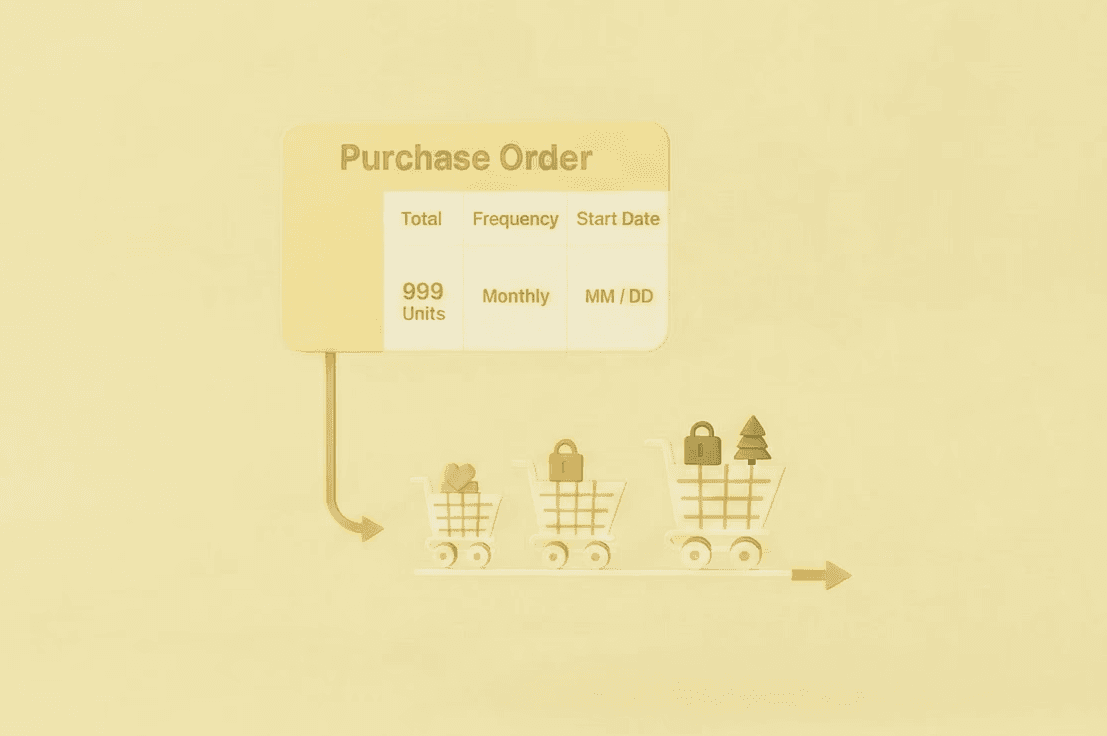Blog
Educational
Inventory Planner vs. Top Competitors: Which Offers SKU‑Level Forecasting?
Inventory Planner vs. Top Competitors: Which Offers SKU‑Level Forecasting?
Laura B
Marketing Analyst
Oct 16, 2025
If you’re choosing an inventory planning app for SKU-level forecasting, prioritize tools that are multi-location native, forecast per SKU and per location with explainable drivers, output a ranked buy list by revenue impact and budget, auto-compose supplier-ready POs (MOQs/case packs/price breaks), recommend transfers before buying, and publish PO-driven ETA windows to PDP/cart.
Inventory Planner is a strong planner in the e-commerce ecosystem; however, brands at $1–10M GMV that need the closed loop (forecast → replenish → buy/transfer → promise → learn) often find Tightly a faster path to execution, while Netstock/EazyStock fit ERP-anchored teams, Slimstock fits complex enterprise planning, KatanaMRP fits sellers who manufacture/kit, Onebeat excels in store transfers/allocations, and Singuli appeals to data-forward teams that want ML + PO planning.
Overview of SKU-Level Forecasting in Inventory Management
A SKU is a specific product variation—size, color, configuration. A tee might be one style but 30 SKUs (S-XL × 5 colors). SKU-level forecasting predicts demand for each variation, not just the parent style. Why that matters:
Aggregated forecast: “We’ll sell 1,000 tees next month.”
SKU-level forecast: “We’ll sell Black-M 320, Black-L 220, Navy-M 180…” — so replenishment is set correctly per variation.
SKU × Location forecasting. A SKU behaves differently in different nodes (DCs, stores, 3PLs, regions).
SKU‑level forecasting predicts demand for each product variation—size, color, style—enabling precise inventory allocation to reduce stockouts and overstocking, unlike aggregated forecasts that treat product lines as single units.
This granularity matters: a single t‑shirt design can generate dozens of SKUs with distinct demand patterns (e.g., medium blue versus extra‑large yellow). SKU‑level forecasts capture those differences so managers can set replenishment and safety stock per variation.
Manual SKU forecasting is time‑consuming (often 2–3 weeks), but AI‑powered inventory management software solutions accelerate and automate this work, reducing spreadsheet errors and improving responsiveness to market changes (see how AI helps consumer goods growth here: https://www.mckinsey.com/industries/consumer-packaged-goods/our-insights/how-ai-can-unlock-growth-in-consumer-goods).
The key contrast: aggregated forecasts might predict 100 units across a line next month, while SKU‑level forecasting specifies quantities per size/color, preventing mismatches between supply and demand for individual variations.
For Beginners: The Small Glossary That De-mystifies Jargon
MOQ / Case pack / Price break — Supplier rules that define minimums, pack sizes, and discount thresholds.
Safety stock — Cushion to absorb demand/lead-time variability.
Service level — Probability you fulfill demand without a stockout.
WAPE vs. MAPE — WAPE weighs big sellers correctly; MAPE can be distorted by tiny SKUs.
ASN — Advance Shipping Notice from a supplier/3PL (pre-receipt signal).
ETA window — Customer-facing ship date range driven by inbound POs (“Ships by Nov 7–10”).
How to Evaluate Tools
Ask vendors to show this in your order of operations:
Explainable SKU (and SKU × location) forecasts
Show driver attributions (trend, seasonality, promo), confidence bands, and how stockouts/launches are handled.
Ranked buy list by ROI & budget
“What should we buy or move first?” with days-to-stockout and expected revenue saved, inside a weekly spend cap.
Supplier-ready POs
Honor MOQs, case packs, price breaks, and vendor lead-time profiles with line-level diffs and approvals.
Transfer recommendations
Compare transfer vs. buy with time/cost; suggest inter-node moves when faster/cheaper than purchasing.
PO-driven ETAs (optional but powerful)
Use inbound POs to publish shopper-visible ETA windows; “Out of stock” becomes “Ships by Nov 7–10.”
Continuous learning
As receipts and sales land, bias shrinks, buffers adjust, and next week’s list gets smarter.
Inventory Planner: Features, Strengths, and Limitations
Inventory Planner provides a unified dashboard for multi‑channel inventory visibility and streamlined purchase order creation, with strong native Shopify integration that captures sales velocity, seasonality, and supplier lead times.
It integrates with Shopify, Amazon, WooCommerce, QuickBooks, and Xero to sync inventory across channels. This makes it a practical choice for merchants seeking a consolidated view and simpler replenishment workflows.
Limitations reported by users include escalating costs as SKUs or advanced features are added, integration gaps with newer platforms, and a steeper learning curve for configuring complex forecasting rules. Forecasts rely mainly on historical sales data, which can underperform for new product launches or abrupt market shifts—an important consideration for fast‑growing brands needing adaptive predictive analytics.
Leading Inventory Planner Competitors with SKU-Level Forecasting
Tightly
Think of Tightly as a simple control room for stock. It looks at demand for each exact product version (that’s a SKU—like “Jogger, Black, Size M”) in each place you store or ship from (a warehouse, a store, or a 3PL). That “SKU × location” view matters because the same item often sells differently in different places. Tightly doesn’t stop at predicting those numbers—it turns them into clear, ready-to-use steps you can take every week.
First, the forecasts are explainable. Instead of a mysterious number, you’ll see what drove the prediction—seasonality (e.g., summer spikes), recent promotions, trends—and a simple confidence range, so you know where to trust the model and where to take a closer look. You don’t need to be a data scientist; the goal is that you can explain the forecast to finance or your supplier in under a minute.
Next, Tightly converts those forecasts into a ranked buy list—a plain list that tells you what to purchase (or move) first, and why. For each SKU/location, it shows how many days until you run out, how much revenue you’ll protect if you replenish now, and it respects a weekly budget cap that you set. This keeps spending focused on the highest-impact items and stops the “we bought too much of the wrong thing” problem.
When you’re ready to buy, Tightly composes supplier-ready purchase orders (POs) automatically. It follows the real rules your vendors care about:
MOQ (minimum order quantity: the smallest amount they’ll accept),
Case packs (how items are boxed, like “sold in 10s”), and
Price breaks (better unit cost at 500+ units, for example).
You also get line-level diffs—a clear “what changed and why” audit trail—so approvals are quick and everyone stays aligned.
Often the cheapest, fastest fix isn’t buying at all—it’s moving stock you already own. Tightly runs transfer-vs-buy simulations automatically. If shifting 120 units from your West warehouse to your East warehouse will prevent a stockout in two days (and a PO would arrive in 12), Tightly will recommend the transfer first. That single choice can save rush shipping and protect margin.
Finally, Tightly helps you keep selling even when on-hand is low by publishing PO-driven ETA windows to your storefront or order system. Instead of “Out of stock,” a product can show “Ships by Nov 7–10,” based on live inbound POs. If a delivery slips, the window updates. Customers get an honest promise, and you keep conversion instead of losing the sale.
Put together, this is why lean, multi-location brands tend to love Tightly. With a small team, you can run the same weekly loop—forecast → ranked buys → POs or transfers → honest ETAs → learn—without hiring a dedicated planner. You spend less time wrestling spreadsheets and more time making a few high-confidence approvals that actually move revenue, service levels, and cash flow in the right direction.
Netstock — an optimization layer that sits on top of your ERP
What it is (in plain English):
Netstock plugs into your ERP (the system your finance and operations teams already use to track products, purchasing, and accounting). Think of it as a planning “brain” that reads the facts from your ERP and then recommends how much stock to hold at each warehouse. It’s especially good at policy tuning—for example, deciding sensible safety stock levels and reorder points for thousands of items without manual tinkering.
When it’s a strong fit:
You already rely on an ERP as your “single source of truth,” you have multiple warehouses, and you want a systematic way to keep service levels high without drowning in inventory. It’s popular with mid-market to enterprise teams that need exception management (surfacing only the items that need attention today).
What to watch carefully:
Data latency. If orders and receipts take hours (or a day) to flow from your ERP/3PL into Netstock and back, you’ll need to carry more buffer stock to stay safe. In a demo, ask the team to show timestamps from order → pick/ship → receipt → plan update so you can see how “live” the loop really is.
Tip for first-timers:
Have a short, simple policy for A/B/C items (fast, medium, slow movers) before you start. Netstock shines when you give it rules to enforce consistently.
Slimstock — deep planning for complex networks
What it is:
Slim4 is a full-scale planning suite designed for companies with many regions, product families, and teams. It spans forecasting, inventory optimization, and often connects into S&OP/IBP (Sales & Operations/Integrated Business Planning)—the monthly process where sales, marketing, supply, and finance align.
When it’s a strong fit:
You run multiple countries or big assortments, have seasonal complexity, and need governance: audit trails, approvals, and structured planning cycles. It excels at network-wide trade-offs (where to hold stock to maximize availability at the lowest total cost).
What to watch carefully:
All that depth can create distance from your storefront. Make sure storefront promises (e.g., delivery windows on product pages) and fast transfers aren’t slowed down by heavyweight processes. The goal is “big-company rigor” without sliding back into side spreadsheets to stay nimble.
Tip for first-timers:
Start with one region or business unit as a pilot and lock a monthly governance rhythm (inputs due, sign-off, review). Scale once the cadence feels natural.
KatanaMRP — inventory plus light manufacturing in one place
What it is:
Katana combines inventory with production planning. If you build products (assemble kits, finish goods from components), it tracks what parts you need, what’s in progress (WIP), and when finished items will be ready.
When it’s a strong fit:
Any business that converts inputs to outputs—think cosmetics, wellness bundles, electronics kits, furniture made to order. It keeps purchasing aligned to bill of materials and production schedules so you don’t run out of a 50-cent part that halts a $200 product.
What to watch carefully:
If you’re pure retail/wholesale (you don’t make or kit anything), Katana’s production features may be more than you need. Confirm the planning outcomes (what to buy, when to buy, where to place inventory) justify the operational footprint of an MRP.
Tip for first-timers:
Clean your BOMs (bill of materials) before onboarding—accurate components and pack sizes are everything.
Odoo — a modular ERP that can house inventory, purchasing, and more
What it is:
Odoo is like a box of Lego for business systems. It offers modules for inventory, purchasing, accounting, CRM, manufacturing, and more—so you can build an end-to-end ERP tailored to your needs.
When it’s a strong fit:
You want to consolidate multiple tools into one suite, and you’re ready to connect your online store(s), marketplaces, and 3PL so everything lives under one roof.
What to watch carefully:
Integration lift. Because Odoo can do so much, projects can grow. Keep the planning loop tight: orders/receipts → plan → PO/transfer → customer promise should move quickly. If it takes days to flow, your team will compensate with extra stock or side processes.
Tip for first-timers:
Decide early which system is the source of truth for product data, suppliers, and inventory adjustments. Make a short RACI (who is responsible, accountable, consulted, informed) to avoid “too many cooks.”
Onebeat — strong at store allocations and transfers
What it is:
Onebeat focuses on retail networks—lots of stores, lots of sizes/colors. It’s built to allocate the right mix to each store and to re-balance inventory with transfers before you rush to buy more.
When it’s a strong fit:
Fashion, footwear, and specialty retail with meaningful store traffic and frequent assortment changes. If “what’s in each store” makes or breaks your week, Onebeat is in its element.
What to watch carefully:
Data freshness and execution speed. Transfers only help if stores receive instructions quickly and follow them. In a pilot, test the end-to-end time: recommendation issued → store picks/ships → receiving store stocks → results visible to planners.
Tip for first-timers:
Pick a small cluster of stores for a 6- to 8-week trial. Measure “size-level availability” on key items; it’s a true signal of whether transfers are working.
EazyStock — policy-driven, mid-market optimization
What it is:
EazyStock helps set safety stock and reorder policies across multiple warehouses, often tied to an ERP. It’s meant to right-size inventory so you carry just enough to hit your service goals, not more.
When it’s a strong fit:
Distributors and mid-market retailers who need to tame large catalogs across a few warehouses, with steady rules and fewer surprises.
What to watch carefully:
Connector maturity and cycle-time from ASN (advance shipping notice) → receipt → inventory update → plan. If those messages lag, buffers creep up. Ask for a live flow demo with timestamps.
Tip for first-timers:
Classify items (A/B/C or “critical/standard/slow”) and agree target service levels per class. EazyStock does best when the “policy” is explicit.
Singuli — machine-learning forecasting plus PO planning
What it is:
Singuli leans into ML models to predict demand (often capturing promo and trend effects) and then pairs that with purchase planning. Think of it as data-science-flavored forecasting with a buying workflow.
When it’s a strong fit:
Teams that love experimentation and want model depth—especially if you have fast-moving catalogs, frequent promotions, or influencer spikes.
What to watch carefully:
Two words: explainability and spend discipline. Make sure the system can show why it recommends a buy and that you can set budget guardrails. Otherwise, “smart” forecasts can still lead to overspending.
Tip for first-timers:
Run a budget-capped pilot on your top 100 SKUs. Compare “expected revenue saved” against actual revenue retained to ground the model in business reality.
Side-by-Side Snapshot
Capability | Tightly | Inventory Planner | Netstock | Slimstock | KatanaMRP | Odoo | Onebeat | EazyStock | Singuli |
|---|---|---|---|---|---|---|---|---|---|
SKU-level forecasting | Yes (explainable) | Yes | Yes | Yes | Yes | Yes | Yes | Yes | Yes (ML) |
SKU × Location forecasting | Yes | Yes (validate depth) | Yes | Yes | Yes | Yes | Yes | Yes | Yes |
Ranked buy list by ROI & budget | Yes | Yes | Policy-driven | Policy-driven | Basic | Rules | Allocation-first | Policy-driven | Yes |
Supplier-ready POs (MOQs/packs/breaks) | Yes (diffs) | Yes | Yes | Yes | Yes | Yes | Yes | Yes | Yes |
Transfer vs. buy recommendations | Yes | Basic–Medium | Yes | Yes | Yes (for WIP/components) | Rules | Strong | Yes | Yes |
PO-driven ETA windows (shopper-visible) | Yes | Varies/limited | Not core | Not core | Not core | With effort | Not core | Not core | Not core |
Best fit | Lean teams needing the full loop | Planning wins fast | ERP-anchored ops | Enterprise/IBP | Makers/kitting | ERP consolidation | Store networks | Mid-market ERP+ | Data-forward ops |
Use this matrix to narrow options, then prove fit with a pilot on your data.
A 90-Day Pilot You Can Actually Run
Weeks 0–2: Connect & clean
Connect commerce platform(s), WMS/3PL, and accounting/ERP.
Import supplier terms (MOQs, case packs, price breaks) and lead-time ranges.
Fix low-hanging data fruit: duplicate SKUs, unit mismatches, missing variants.
Weeks 3–4: Forecast validation (top 100 SKUs)
Compare model vs. actuals.
Mark new launches, promo noise, and stockout “false zeros.”
Log overrides with reasons (this becomes governance).
Weeks 5–8: Ranked replenishment on (budget-capped)
Approve weekly buys within a fixed spend.
Track stockout sessions, PO cycle time, expected revenue saved (avoided lost sales).
Weeks 9–12: “Always selling”
Trial PO-driven ETA windows on 5–10 hero SKUs.
Watch conversion and cancellations.
Tighten buffers where on-time receipts are consistent.
Pilot success looks like: fewer expedites, tighter buys, calmer Fridays, and KPIs moving in the right direction.
FAQs
Do I really need SKU × location forecasting?
If you stock in more than one node—or sell across regions—the same SKU behaves differently by node. Planning at SKU × location cuts stockouts and overbuys versus using one global number.
What’s the fastest way to see value?
Run a 4–8 week pilot on your top 100 SKUs: enable the ranked buy list with a weekly budget, send supplier-ready POs, and (optionally) turn on PO-driven ETA windows for a handful of products.
Which tool is “best”?
There isn’t one winner. If you want the full loop with a lean team, Tightly will feel like a superpower. If ERP rules your world, look at Netstock or EazyStock. If you manufacture or kit, KatanaMRP is home turf. Store networks live or die by Onebeat. Want something planner-friendly without a big lift? Try Inventory Planner. Prefer data-forward ML exploration? Singuli. Need enterprise IBP? Slimstock.
Laura B
Marketing Analyst
Share






